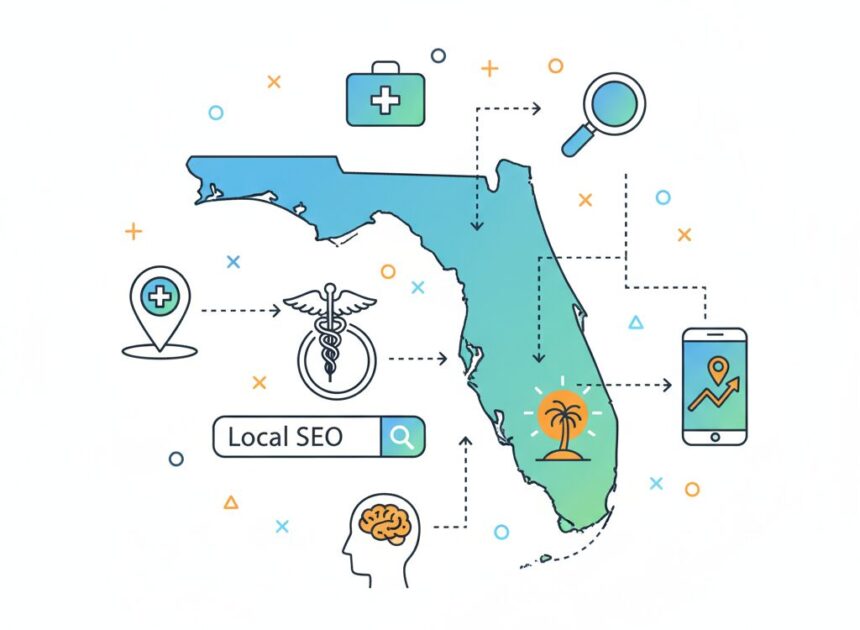In the competitive landscape of South Florida’s specialized medical services, a practice’s digital presence is paramount. For prospective patients seeking high-value procedures in cosmetic surgery, Miami dermatology, or dentistry, the journey almost invariably begins with a local search. The single most powerful asset in this initial engagement is not the practice’s website, but its Google Business Profile (GBP). This guide provides a strategic framework for transforming the GBP from a passive listing into a dynamic, patient-attracting engine that directly influences rankings in Google’s coveted “Local Pack.”
Mastering Your Google Business Profile
The Centrality of GBP in Healthcare Local SEO
Local Search Engine Optimization (SEO) for healthcare is a critical component of any modern patient acquisition plan. At its core, local SEO ensures a practice is discoverable at the precise moment a potential patient is actively seeking care in their geographic vicinity. The cornerstone of this strategy is the Google Business Profile, a tool that functions as a practice’s digital storefront within Google’s ecosystem. Its importance cannot be overstated; according to industry analysis, Google Business signals are a top local ranking factor for search results.
When a potential patient in Miami searches for a high-intent query like “best cosmetic surgeon miami” or “dermatologist near me,” Google’s primary objective is to provide the most relevant, trustworthy, and geographically proximate results. These results are most prominently displayed in the “Local Pack” or “Map Pack”—the block of three business listings that appears at the top of the search results page, complete with a map. This feature appears in an estimated 93% of all local searches, and the businesses listed within it receive the vast majority of user clicks and engagement. Securing a position in this space is therefore non-negotiable for growth. A comprehensive Google My Business for doctors strategy is the most direct path to achieving this visibility. The GBP should not be viewed as a simple directory listing but as a “micro-website” that the practice controls, offering a direct line of communication to prospective patients at their moment of highest intent.
Core Optimization: Building the Foundation of Trust and Accuracy
Before a practice can leverage advanced GBP features, it must establish a flawless foundation built on accuracy and consistency. Google’s algorithm rewards trust, and these core elements are the primary signals of a legitimate and reliable medical practice.
Claiming and Verification
The essential first step is to claim and verify ownership of the GBP listing for each physician and practice location. This process is critical to prevent unauthorized changes and to take control of the information presented to the public. Verification typically involves Google mailing a physical postcard with a unique code to the practice’s listed address. This step confirms the practice’s physical location, a crucial factor for local search rankings, and unlocks the ability to fully manage the profile, respond to reviews, and access performance analytics. Given that providers often move between residency, fellowships, and different practices, it is common for outdated or incorrect listings to exist, making a proactive claiming process vital.
NAP (Name, Address, Phone) Consistency
The uniformity of a practice’s core business information—Name, Address, and Phone number (NAP)—across the entire web is a fundamental pillar of local SEO. NAP consistency is critical because Google cross-references this data from the practice’s website, its GBP, and hundreds of other online directories and citation sources (e.g., medical directories, local business listings) to validate its information. Any inconsistency, such as a slight variation in the practice name, an old address, or a different phone number, creates confusion for the search engine’s crawlers. This confusion erodes trust and can severely dilute the practice’s ranking authority, as Google is less confident in the accuracy of the information it is presenting to users. Establishing a single, canonical version of the NAP and ensuring its meticulous application everywhere online is a non-negotiable prerequisite for success.
Strategic Category Selection
Choosing the correct business categories within GBP is a critical signal to Google about the nature of the practice’s services. The primary category should be the most accurate, high-level descriptor, such as “Plastic Surgeon,” “Dermatologist,” or “Dentist”. However, the strategic advantage lies in the selection of specific secondary categories. For example, a dermatology practice that also offers cosmetic treatments should add secondary categories like “Medical Spa” or “Skin Cancer Treatment Center”. A plastic surgeon might add “Hand Surgeon” or “Laser Hair Removal Service”. These additions allow the practice to appear in a wider net of relevant, niche searches, signalling to Google the full breadth of its expertise and increasing its opportunities to rank for more specific patient needs.
Advanced Optimization: Features That Drive Engagement and Conversion
With a solid foundation in place, practices can leverage GBP’s advanced features to gain a significant competitive edge. These elements transform the profile from a static data point into an interactive and persuasive marketing channel designed to get more patients in Miami.
Compelling Business Description
The business description is a prime opportunity to communicate the practice’s unique value proposition. This concise summary should be crafted to not only inform potential patients but also to naturally incorporate primary keywords and phrases, such as ‘board-certified cosmetic surgeon in Miami’ or ‘specializing in advanced dental implants’. It should highlight key differentiators, such as specific technologies, a focus on patient comfort, or the physician’s unique approach, to resonate with the target audience in affluent South Florida markets.
High-Quality Visuals
Visuals are a powerful tool for building trust and conveying a premium experience. Data shows that GBP profiles featuring photos receive, on average, 42% more requests for driving directions and 35% more clicks through to their websites than those without. A strategic visual portfolio should include high-resolution, professional photographs of the facility’s exterior and welcoming interior, the medical team (to humanize the practice), and advanced, modern equipment. These images help potential patients visualize their experience and instill confidence in the quality of care provided.
The “Services” Feature
The “Services” section of GBP is a vastly underutilized tool. It allows a practice to list and describe every single procedure and treatment it offers, from “Botox” and “Dermal Fillers” to “Rhinoplasty,” “Mohs Surgery,” and “CEREC Dental Crowns”. Each service can have its own description and even pricing information. By meticulously populating this section, a practice creates dozens of additional entry points for searchers, enabling it to rank for highly specific, long-tail queries that indicate strong commercial intent.
Google Posts for Timeliness and Promotions
The Google Posts feature allows practices to share timely updates, announcements, and promotions directly on their GBP listing. This content appears prominently in the search results and can be used to highlight a specific procedure, introduce a new piece of technology, share a recent blog article, or announce a community health event. Using this feature regularly sends powerful “activity signals” to Google, indicating that the practice is active, engaged, and consistently providing fresh information, which can positively influence rankings.
Leveraging the Q&A Feature
The Questions & Answers section on a GBP is a public forum where anyone can ask a question about the practice. Proactive management of this feature is essential. Practices should populate this section themselves by asking and answering the most common questions patients have. Queries like, “What is the recovery time for a facelift?”, “Do you offer virtual consultations?”, or “What insurance plans do you accept?” can be addressed directly. This strategy allows the practice to control the narrative, provide valuable information upfront, and strategically integrate relevant keywords, further optimizing the profile for search.
Strategic Implications
The most effective medical practices understand that their Google Business Profile is not a “set it and forget it” utility; it is a dynamic content platform. Those that consistently update their GBP with new photos, posts, and Q&A responses are sending continuous signals of activity and relevance to Google’s algorithm. This consistent engagement is interpreted as a sign of a vibrant, trustworthy, and authoritative business, leading to demonstrably higher rankings over less active competitors. A practice’s monthly marketing plan must therefore include a recurring task to update and enrich the GBP, treating it with the same strategic importance as its website blog or social media channels.
Furthermore, a fully optimized GBP fundamentally shortens the patient’s decision-making journey. By providing a comprehensive suite of information services, verified reviews, professional photos, and answers to common questions—directly within the search results page, the profile can build sufficient trust to drive a direct action. A potential patient can get the answers they need and decide to call the office, click for directions, or visit the website without ever needing to compare multiple other sites. This makes the Google Business Profile the single most efficient patient acquisition tool in the entire marketing stack, converting searchers into qualified leads at the very top of the sales funnel and providing a decisive competitive advantage before a competitor’s website is ever even visited.
Architecting for Conversion: High-Performance Service & Location Pages
Once a potential patient clicks through from a Google Business Profile or an organic search result, the practice’s website becomes the critical arena for conversion. In the discerning and affluent markets of South Florida, a generic, uninspired website is a liability. This section deconstructs the anatomy of high-converting service pages, designed specifically to build immediate trust, convey elite expertise, and create a frictionless path from initial interest to a scheduled consultation.
The Psychology of the High-Value Patient: Trust Before Treatment
For elective, high-value medical procedures, the patient’s decision-making process is driven by a search for quality, not a bargain. This demographic is not seeking the cheapest option; they are seeking the best and safest option. An analysis of the websites of top cosmetic surgeons in Miami reveals a consistent and deliberate focus on establishing authority and artistry. These sites prominently feature physician credentials, multiple board certifications, academic affiliations, and a narrative that frames the surgeon as a trusted expert and artist. Price is rarely, if ever, the leading message.
This underscores a critical principle: the website must immediately convey expertise, safety, and a premium patient experience. According to consumer behaviour studies, a staggering 75% of individuals judge a business’s credibility based on its website design alone. For a decision as significant as cosmetic surgery or complex dental Palm Beach, this figure is undoubtedly higher. A website that appears dated, is difficult to navigate, or loads slowly introduces friction and doubt. This digital friction can subconsciously transfer to the patient’s perception of the practice’s clinical competence, undermining trust before it can be established.
Anatomy of a High-Converting Service Page
A high-converting service page is not merely a list of procedures. It is a carefully architected persuasive asset that guides the visitor from curiosity to confidence. Synthesizing best practices in user experience and healthcare marketing in South Florida, the following elements are essential for every core service page.
Clear Value Proposition & Headline
A visitor should understand what the page is about and why it matters to them within seconds. The headline must be clear, compelling, and patient-focused. A generic headline like “Our Services” is ineffective. A powerful headline combines the procedure with a key benefit and a local signal. For example: “Natural-Looking Rhinoplasty in Miami by Double Board-Certified Surgeon Dr. [Name].” This immediately communicates the service, the desired outcome, the location, and the primary trust signal (the surgeon’s credentials).
Patient-Centric Language
The copy on the page should resonate with the patient’s goals, concerns, and emotions. It is crucial to replace cold, clinical jargon with warm, empathetic language that focuses on benefits and outcomes. Instead of listing “rhytidectomy,” the page should speak to the patient’s desire to “achieve a more youthful, refreshed appearance.” This patient-centric approach demonstrates understanding and builds rapport.
Prominent Trust Signals
In healthcare, trust is the ultimate currency. A service page must be saturated with signals that validate the practice’s expertise and credibility. Strategic placement of the following is paramount:
- Physician Credentials: Board certifications (e.g., American Board of Plastic Surgery), memberships in prestigious societies (e.g., American Society for Aesthetic Plastic Surgery), academic appointments, and years of experience should be clearly visible. The competitive Miami market shows surgeons promoting “Double Board-Certified” or even “Quadruple Board-Certified” status to stand out.
- Patient Testimonials and Reviews: Social proof is incredibly persuasive. The page should feature star ratings and direct quotes from satisfied patients, ideally pulled from trusted third-party platforms like Google, RealSelf, or Healthgrades. The success of top competitors, such as one Miami surgeon with over 600 5-star Google reviews, demonstrates that a high volume of positive feedback is a critical competitive differentiator.
- High-Quality Visuals: For aesthetic specialties, a comprehensive gallery of professional before-and-after photos is non-negotiable. These images provide tangible proof of the surgeon’s skill. Additionally, short, physician-led videos explaining the procedure can be highly effective in building a personal connection and establishing authority.
Frictionless Calls-to-Action (CTAs)
A high-converting page makes the next step obvious and easy. A prominent, consistently placed “Book a Consultation” or “Schedule an Appointment” button should be located in the website’s header and repeated throughout the service page. Recognizing that not all visitors are ready to commit immediately, it is wise to offer multiple CTA options. Secondary CTAs like “Request a Virtual Consultation,” “View Our Gallery,” or “Ask a Question” can capture leads from individuals who are still in the research phase. For mobile users, who constitute the majority of web traffic, a “click-to-call” button that allows them to dial the office directly from the website is an essential feature.
Comprehensive Educational Content
Answering a patient’s questions before they have to ask is a powerful way to build trust and authority. Each service page should include a detailed description of the procedure, a section on who makes an ideal candidate, an overview of the recovery process, and a dedicated Frequently Asked Questions (FAQ) section. This educational content not only helps the patient make an informed decision but also provides valuable text for search engine optimization, helping the page rank for a wider range of queries.
Multi-Location Strategy: Dominating Hyperlocal Markets
For medical practices that operate multiple offices in different South Florida communities—for example, in Miami, Fort Lauderdale, and Palm Beach—a one-size-fits-all website is an ineffective local SEO strategy. A potential patient in Boca Raton searching for a “dermatologist near me” expects to find information specifically relevant to their community, not a generic corporate page that lists all locations equally.
To capture this hyperlocal search intent, it is critical to create a unique, dedicated landing page for each physical office location. Each of these pages must be optimized with unique content, including:
- The specific Name, Address, and Phone number (NAP) for that location.
- An embedded Google Map for easy directions.
- High-quality photos of that specific office’s interior and exterior.
- Biographies of the doctors and key staff members who practice at that location.
- Testimonials from patients who live in or near that community.
Furthermore, the on-page text, titles, and headings should be optimized for location-specific keywords, such as ‘cosmetic dentist in Palm Beach Gardens’ or ‘Botox injections in Wellington’. This tells both users and search engines that the practice has a dedicated presence and deep commitment to serving that specific local market.
Strategic Implications
The most effective medical service pages are architected to function as a “digital consultation.” They anticipate and proactively answer the very questions a patient would ask a doctor during an initial meeting. The page’s structure should mirror the natural flow of a real-world consultation: first, it introduces the expert and establishes their credentials (doctor’s bio); next, it explains the proposed solution and its benefits (procedure details); then, it provides tangible proof of success (before-and-after photos and patient testimonials); and finally, it clearly defines the next step (the call-to-action). This deliberate, persuasive narrative builds rapport and pre-sells the patient on the physician’s expertise and the high probability of a positive outcome, significantly increasing the likelihood of conversion.
In the luxury medical market of South Florida, the aesthetic and functional quality of a practice’s website serves as a direct and powerful proxy for its perceived clinical quality. A website that is slow to load, visually cluttered, or difficult to navigate does more than just frustrate a user; it plants a seed of doubt. This doubt can subconsciously transfer to the patient’s perception of the practice’s attention to detail, professionalism, and overall medical competence. For an affluent patient evaluating a high-cost, high-stakes elective procedure, this can be a fatal flaw. Therefore, investing in premium, user-centric web design is not merely a marketing expense. It is a fundamental investment in the practice’s clinical reputation and a direct driver of the patient trust that is essential for converting high-value leads.
The Trust Economy: A HIPAA-Compliant Framework for Online Reputation Management
In the modern healthcare ecosystem, a practice’s reputation is its most valuable currency. It is built not only through clinical excellence but also through the digital narrative crafted by patient reviews. This section provides a comprehensive, legally sound framework for online reputation management, covering both proactively generating a steady stream of positive reviews and reactively managing all forms of feedback. The objective is to build a powerful and positive online reputation that drives patient acquisition while adhering strictly to the patient privacy regulations mandated by the Health Insurance Portability and Accountability Act (HIPAA).
The Undeniable Impact of Reviews on Ranking and Revenue
Online reviews are no longer a passive element of a practice’s digital footprint; they are an active and powerful driver of business success. From a technical SEO perspective, review signals—including the quantity, velocity, and overall rating of reviews—are one of the most significant factors influencing a practice’s rank in Google’s local search results. Google’s algorithm interprets a consistent flow of positive patient feedback as a strong indicator of a practice’s quality, authority, and relevance to the local community, rewarding it with higher visibility in the Local Pack.
From the patient’s perspective, the impact is even more direct. An overwhelming 94% of patients now use online reviews to evaluate and select healthcare providers. In an era of digital-first decision-making, online reviews have become the modern equivalent of a trusted word-of-mouth referral. They serve as a critical form of social proof, offering prospective patients an unfiltered glimpse into the experiences of others and significantly influencing their choice of provider. A strong portfolio of positive reviews builds immediate trust and credibility, while a lack of reviews—or a prevalence of negative ones—can be a major deterrent.
Building a Proactive Review Generation System
The most effective reputation management strategy is proactive, not reactive. Rather than waiting for reviews to trickle in organically, successful practices implement a systematic process to consistently encourage feedback from their satisfied patients. This creates a powerful asset that continually bolsters their local SEO and attracts new patients. An effective system incorporates the following tactics:
- Strategic Timing: The ideal time to request a review is at the moment of peak patient satisfaction. This could be immediately following a successful procedure, during a positive follow-up appointment, or after receiving a compliment about their experience. The request should be a natural extension of a positive interaction.
- Frictionless Process: The easier it is for a patient to leave a review, the more likely they are to do so. Practices should provide patients with a direct link that takes them to the review platform of choice—primarily the practice’s Google Business Profile. This link can be delivered via a post-appointment text message or email. In-office tools, such as a tablet at the checkout desk or a printed card with a QR code that links directly to the review page, can also be highly effective.
- Systematic Automation: To ensure consistency and scalability, practices should leverage patient communication or reputation management software to automate the review request process. An automated text or email can be sent to every patient a day or two after their appointment, thanking them for their visit and politely inviting them to share their experience. This removes the burden from staff and ensures no opportunity is missed.
- Staff Education and Training: The entire team, particularly front-desk staff, should be educated on the critical importance of online reviews to the practice’s growth. They should be trained on simple, professional scripts to use when verbally encouraging satisfied patients to leave feedback. A simple, “We’re so glad you had a great experience today. Patients like you often find us through online reviews, and it would mean a lot to us if you’d consider sharing your feedback on Google,” can be very effective.
The HIPAA Tightrope: Responding to Reviews Without Violating Privacy
Responding to online reviews is a crucial part of managing a practice’s reputation, as it shows that the practice is engaged and values patient feedback. However, for healthcare providers, this engagement is governed by the strict privacy rules of HIPAA. This is the most nuanced and legally sensitive aspect of reputation management, and a misstep can lead to significant penalties and a loss of patient trust. Crafting HIPAA-compliant review responses is paramount.
The core principle of HIPAA compliance in this context is the absolute prohibition on disclosing any Protected Health Information (PHI). Critically, this includes the simple act of confirming that the person who left the review is, in fact, a patient of the practice. Even if the reviewer openly discusses their condition and treatment, this “patient’s own disclosure is not permission for the doctor to disclose anything”. The obligation to protect privacy remains solely with the provider.
Adherence to this principle requires a strict protocol for responding to all types of reviews:
Responding to Positive Reviews
Even with positive feedback, caution is required. Responses should be general, brief, and appreciative, but must not confirm a patient-provider relationship.
- Safe Response: “Thank you for taking the time to share your feedback. We appreciate hearing from our community.”
- HIPAA Violation: “Thank you for your kind words, Mrs. Smith. We’re so glad you are happy with your rhinoplasty results, and we look forward to seeing you at your follow-up appointment.”
Responding to Negative Reviews
Managing negative reviews requires a calm, strategic, and disciplined approach. The goal is not to win an argument but to demonstrate professionalism and move the conversation to a secure, private channel.
- Pause Before Responding: An immediate, emotional response can escalate the situation. It is best to take time to formulate a calm, professional, and compliant reply.
- Never Acknowledge Patient Status: The response must never confirm or deny that the reviewer was a patient. This is the most common and dangerous mistake.
- Keep the Response General and Policy-Focused: Do not address the specific clinical or administrative complaints in the review. Instead, speak to general office policies or standards of care. For instance, if a review complains about a long wait time, a safe response is: “Our practice is committed to providing timely and efficient care for all our patients, and we take all feedback seriously as an opportunity to review our processes.”.
- Take the Conversation Offline: This is the ultimate objective of any public response to a negative review. The reply should always conclude with a clear and polite invitation to discuss the matter privately. A template response should be used: “We are sorry to hear about your experience. Due to patient privacy regulations, we cannot discuss specific situations in a public forum. We would appreciate the opportunity to address your concerns directly. Please contact our practice manager, [Name], at [Phone Number] so we can assist you personally.”.
Strategic Implications
The stringent constraints of HIPAA create a unique dynamic in online reputation management for medical practices. A practice can never truly “win” an argument or correct a false claim in a public review forum, because doing so would almost certainly require disclosing PHI, leading to a privacy violation. This reality means that the only viable long-term defence against the impact of negative reviews is a powerful and relentless offence. The strategic imperative must shift from reacting to negative feedback to proactively generating an overwhelming volume of positive reviews. When a practice has hundreds of glowing, 5-star testimonials, the occasional negative comment becomes a statistical outlier, its impact drowned out by the powerful and persuasive consensus of the satisfied majority. This makes the implementation of a systematic, operational review acquisition process the absolute cornerstone of reputation defence.
Furthermore, a practice’s online reputation is a direct and unfiltered reflection of its internal patient experience and communication protocols. A pattern of negative reviews is not merely a “marketing problem” to be managed; it is an “operational problem” to be solved. These reviews represent invaluable business intelligence, highlighting systemic issues that may be invisible to the practice’s leadership, such as inefficient scheduling, poor front-desk communication, or confusing billing procedures. Therefore, the marketing team or agency responsible for reputation management must establish a formal feedback loop with the practice’s operational leadership. The data and sentiment from online reviews should be analyzed to identify root causes of patient dissatisfaction and drive genuine process improvement. This creates a virtuous cycle: using negative feedback to improve operations leads to better patient experiences, which in turn generate more positive reviews, which boost local SEO, build trust, and ultimately attract more of the right patients.
Attracting the Right Patients: Advanced Keyword and Content Strategies
To dominate the affluent and competitive South Florida medical market, a practice’s digital strategy must be laser-focused on attracting high-value patients who are actively seeking specialized procedures. This requires a sophisticated approach to keyword research and content creation that moves beyond generic terms and establishes the practice as the definitive topical authority in its niche. The objective is to capture patient interest at every stage of their decision-making journey, from initial research to the final selection of a provider.
Keyword Strategy: Targeting Commercial Intent
An effective keyword strategy is the foundation of any successful SEO campaign. The focus must be on identifying and targeting terms that signal a user is not just browsing for information, but is close to making a purchase decision. This involves a multi-layered approach to keyword selection for high-intent local searches.
Geo-Specific Keywords
This is the bedrock of local SEO. The strategy involves combining a core service or specialty with a specific location. Examples include foundational terms like ‘local seo for doctors Miami’, ‘healthcare marketing south florida’, and ‘medical seo fort Lauderdale’. For patient-facing searches, this translates to phrases such as ‘cosmetic surgery Miami’, ‘dermatology Fort Lauderdale’, or ‘dental Palm Beach’. These keywords capture users who have a defined need within a specific geographic area.
High-Intent Procedural Keywords
These are often called “money keywords” because they are used by searchers who have already decided on a specific treatment and are now actively looking for a provider. These queries have extremely high commercial intent and are among the most valuable to rank for. Examples include:
- ‘rhinoplasty near me’
- ‘best facelift surgeon in Boca Raton’
- ‘lip fillers in Miami’
- ‘dental implants palm beach’
- ‘Botox injections Fort Lauderdale’
Long-Tail Keywords for Doctors
These are longer, more specific, and often question-based phrases that capture potential patients who are earlier in their research phase. While they have lower individual search volume, they are often less competitive and convert at a high rate because they match a very specific need. Targeting these long-tail keywords for doctors with educational content allows a practice to build trust early in the patient’s journey. Examples include:
- ‘How much does a dermatologist cost for acne?’
- ‘recovery time from tummy tuck Miami’
- ‘best non-surgical alternatives to a facelift’
- ‘dermatologist who specializes in hair loss fort lauderdale’
Content Strategy: Building Authority and Trust
Once the target keywords are identified, a robust content strategy is needed to create web pages and articles that will rank for those terms. The content must be comprehensive, authoritative, and patient-focused, designed to build trust and establish the practice as a leading expert.
Dedicated Service Pages
The single most common and critical SEO mistake made by medical practices is failing to create a unique, in-depth page for every single condition they treat and every procedure they offer. A generic, consolidated “Our Services” page will never have enough relevance or authority to rank for competitive procedural keywords. A successful strategy requires building out a dedicated, highly optimized page for each service, such as “Acne Scar Treatment,” “Mohs Surgery,” “Porcelain Veneers,” or “Breast Augmentation”. Each page becomes a targeted asset designed to capture a specific type of patient.
Localized Blog Content
A practice blog is a powerful tool for building local relevance and attracting a wider audience. By publishing articles that address community-specific or seasonal health topics, a practice can connect with its local market on a deeper level. For example, a South Florida practice could publish posts titled “The Ultimate Skincare Routine for South Florida’s Summer Humidity” or “Navigating Allergy Season in Fort Lauderdale”. This type of content provides genuine value to local residents and helps the practice rank for relevant, location-based search terms.
Answering Patient Questions
A significant portion of search queries are phrased as questions. Creating content that directly answers the most common questions patients have about procedures, conditions, and costs is a highly effective strategy for capturing long-tail keyword traffic. A blog post titled “What Are the Risks of Liposuction?” or an FAQ page addressing queries like “Does Insurance Cover Cosmetic Surgery?” positions the practice as a transparent and helpful educational resource, building trust with potential patients during their critical research phase.
Physician-Led Video Content
Video is an increasingly dominant medium online, and since Google owns YouTube, it is also a potent SEO tool. Creating a series of short, professional videos where the practice’s physicians answer frequently asked questions is a powerful way to build a personal connection and demonstrate expertise. These videos can be embedded on the corresponding service pages of the website, shared on social media, and optimized to appear in both Google and YouTube search results, greatly extending the practice’s reach.
Technical & Off-Page SEO: The Supporting Pillars
While content is king, it needs a strong technical and off-page foundation to achieve its full potential. These supporting pillars ensure that search engines can find, understand, and trust the practice’s website.
Citations and Medical Directories
Off-page SEO for local practices begins with citations. A citation is any online mention of a practice’s Name, Address, and Phone number (NAP). Ensuring that this information is accurate and perfectly consistent across all major online directories is a foundational local authority signal for Google. It is imperative for practices to claim and optimize their profiles on key medical-specific directories where patients frequently begin their search, such as Healthgrades, Vitals, Zocdoc, and, for aesthetic practices, RealSelf.
Schema Markup (Structured Data)
Schema markup is a form of microdata that can be added to a website’s code to help search engines better understand its content. Implementing specific schema types like “Doctor,” “MedicalClinic,” and “MedicalService” provides search engines with explicit information about the physicians’ qualifications, the practice’s specialty, and the procedures offered. This can lead to the generation of “rich snippets” in the search results—enhanced listings that may include star ratings, photos, or other information—which can significantly improve click-through rates.
Image Optimization
In visual specialties like cosmetic surgery, dermatology, and cosmetic dentistry, images are a primary component of the content. Optimizing these images for search is crucial. This involves more than just using high-quality photos; it means strategically naming the image files with relevant keywords (e.g., ‘rhinoplasty-before-after-miami.jpg’) and writing descriptive alt text that accurately describes the image for both search engines and visually impaired users. This helps the practice’s images appear in Google Image Search, creating another valuable source of patient traffic.
Strategic Implications
A successful content strategy for a high-end medical practice must operate on two parallel tracks. The first is the “Commercial Track,” which utilizes highly optimized, procedure-specific service pages to capture patients at the bottom of the marketing funnel—those who have already decided on a treatment and are actively searching for a provider. The second is the “Authority Track,” which leverages educational blog posts, articles, and videos to engage potential patients who are higher in the funnel and still in the research phase. This second track is crucial for building trust and establishing the physician as the go-to expert in their field long before the patient is ready to commit to a consultation. Neglecting the Authority Track leaves a practice vulnerable to competitors who are building those critical early-stage relationships and positioning themselves as the trusted choice.
Ultimately, in the specialized medical field, every patient question that goes unanswered on a practice’s website represents a missed opportunity that a competitor will inevitably capture. By methodically creating a comprehensive “content moat”—a deep and wide collection of articles, FAQs, and videos that address every conceivable question, concern, and consideration a potential patient might have about a procedure—a practice can achieve more than just high rankings. It can fundamentally reframe the competitive landscape. The practice is no longer viewed as just another service provider among many; it becomes the definitive, trusted educational resource for its specialty in the South Florida market. For many patients who have been guided and educated by this content, the eventual choice of which provider to book a consultation with becomes a foregone conclusion.
The South Florida Digital Battlefield: A Competitive Analysis and Strategic Roadmap
To succeed in the highly saturated and sophisticated medical markets of South Florida, a practice must not only implement best practices but also understand the specific strategies employed by its top competitors. This final section synthesizes all previous concepts into an actionable competitive analysis and a strategic roadmap. It deconstructs the digital presence of leading practices in Miami, Fort Lauderdale, and Palm Beach to reveal their strengths, identify opportunities, and provide a clear, phased plan for achieving market penetration and digital dominance.
Deconstructing the Market Leaders: What Success Looks Like
An analysis of top-performing practices across cosmetic surgery, dermatology, and dentistry reveals common themes and market-specific nuances that define digital success in South Florida.
Cosmetic Surgery (Miami)
The cosmetic surgery Miami market is characterized by intense competition and a strong focus on the surgeon’s personal brand. An examination of leading practitioners like Dr. Marcelo Ghersi, Dr. Salomon Puyana, Dr. Alexander Zuriarrain, and Dr. Ary Krau highlights several key strategies. Their digital marketing is not about selling a “tummy tuck”; it is about selling Dr. Zuriarrain’s expertise in performing that procedure. Credentials are a primary marketing tool, with terms like “Double Board-Certified” and “Quadruple Board-Certified” used prominently to establish elite status. Their websites feature extensive, high-quality before-and-after galleries and are saturated with glowing patient testimonials. Furthermore, they maintain a strong presence on visual and review-centric third-party platforms like RealSelf, which are critical for patient decision-making in this specialty.
Dermatology (Fort Lauderdale)
The leading dermatology Fort Lauderdale practices successfully blend medical and cosmetic services in their marketing. A review of competitors such as Dr. Mark Bernhardt, Elias Dermatology, and Natura Dermatology reveals a focus on trust and high-volume social proof. Local accolades are leveraged as powerful trust signals, with practices prominently displaying awards like “Voted Best Dermatologist in Fort Lauderdale”. The most dominant players have made review generation a core operational priority. Elias Dermatology, for example, boasts of having over 1,000 5-star reviews, creating a formidable “reputation moat” that is difficult for competitors to overcome. Their service offerings are clearly delineated between medical (e.g., skin cancer) and cosmetic (e.g., body contouring) to appeal to different patient needs.
Dentistry (Palm Beach)
In the affluent Palm Beach market, top dental practices position themselves as providers of luxury, high-value cosmetic and restorative care. Competitors like Advanced Dental Group, Palm Beach Dental Excellence, and Palm Beach Dental Specialists emphasize a premium patient experience for dental Palm Beach. Their marketing focuses heavily on high-revenue procedures like dental implants and porcelain veneers. They highlight the use of advanced technology (e.g., “CEREC Dental Crowns,” “Digital 3D/panoramic X-rays”) as a key differentiator. Patient comfort is a central theme, with services like “Sedation Dentistry” prominently featured to alleviate patient anxiety. The overall branding often evokes a sense of a “luxury clinic” or “premier” service, aligning with the expectations of the local demographic.
The Competitive Digital Presence Matrix
To move from qualitative observation to quantitative strategy, a practice must benchmark its digital assets against the market leaders. The following matrix provides a snapshot of key performance indicators for representative top competitors. This tool allows a practice to identify specific gaps and set concrete, measurable goals for its own healthcare marketing in South Florida.
| Practice Name (Specialty, City) | GBP Completeness (Est. %) | Google Review Volume | Google Review Avg. Rating | Key Medical Directory Presence | Website: # of Indexed Service Pages | Key Differentiator / Insight |
| Zuri Plastic Surgery (Cosmetic, Miami) | 95-100% | 600+ | 4.9+ | Strong (Google, RealSelf) | 20-30 | Brand built on the unique “Quadruple Board-Certified” status. |
| Elias Dermatology (Derm, Ft. Lauderdale) | 90-95% | 1000+ | 4.9+ | Strong (Google, Zocdoc) | 30-40 | Dominates local search through sheer volume of positive reviews. |
| Palm Beach Dental Specialists (Dental, PB) | 85-90% | 150+ | 4.8+ | Moderate | 15-20 | Positions as a “luxury clinic” for complex, high-value prosthodontic cases. |
| Dr. Ary Krau (Cosmetic, Miami) | 90-95% | 400+ | 4.8+ | Strong (Google, RealSelf) | 15-25 | Leverages 30+ years of experience and media appearances (“Miami Slice”). |
| Broward Dermatology (Derm, Ft. Lauderdale) | 80-85% | 200+ | 4.7+ | Moderate | 10-15 | Emphasizes Ivy League credentials (Yale, Harvard) and local awards. |
| Advanced Dental Group (Dental, WPB) | 90-95% | 300+ | 4.9+ | Strong (Google, Zocdoc) | 25-35 | Diversifies with high-value adjacent services like Facial Esthetics. |
This matrix transforms abstract goals like “get more patients in Miami” into a data-driven action plan. A practice can see that to compete with Elias Dermatology, for example, a goal of reaching 100 reviews is insufficient; the target must be significantly higher. It clarifies that a competitive website needs dozens of dedicated service pages, not just a handful. This data provides the necessary baseline for developing a realistic and targeted marketing strategy.
Strategic Roadmap: A 12-Month Plan for Market Penetration
Based on the comprehensive analysis, the following phased, 12-month roadmap provides an actionable plan for a practice to significantly improve its local SEO performance and patient acquisition rate.
Months 1-3 (Foundation)
The initial phase focuses on correcting foundational issues and establishing core systems to ensure all future efforts are built on solid ground.
- Google Business Profile Overhaul: Conduct a full audit and complete optimization of the GBP for all providers and locations, following the detailed framework in Section 1.
- Website Conversion Optimization: Rebuild the five most profitable service pages on the website using the high-converting template outlined in Section 2. Focus on clear value propositions, trust signals, and frictionless CTAs.
- Reputation System Implementation: Deploy a systematic, HIPAA-compliant review generation and response system as detailed in Section 3. The goal is to establish a consistent flow of new, positive reviews on Google.
Months 4-9 (Authority Building)
With the foundation in place, the focus shifts to content creation and off-page authority to broaden the practice’s digital footprint.
- Content Cadence: Begin a consistent content creation schedule, publishing a minimum of two educational blog posts and one physician-led video per month, targeting the long-tail keywords identified in Section 4.
- Service Page Expansion: Methodically build out dedicated, SEO-optimized service pages for all remaining procedures and treatments offered by the practice.
- Citation and Directory Cleanup: Conduct a comprehensive citation audit to find and correct any inconsistencies in the practice’s NAP across all major medical and local business directories.
Months 10-12 (Expansion & Dominance)
In the final phase, the strategy leverages the established authority to expand reach and dominate specific market segments.
- Hyperlocal Targeting: If the practice has multiple locations, develop and launch the unique, location-specific landing pages described in Section 2.
- Data-Driven Optimization: Analyze performance data from Google Analytics and GBP Insights to identify high-performing content and keywords. Double down on what is working by creating more content around those successful topics.
- Launch Paid Campaigns: With a strong organic foundation and high-converting web pages now in place, launch targeted paid advertising campaigns (e.g., Google Ads) to capture additional high-intent traffic and accelerate lead generation.
Strategic Implications
A deep analysis of the South Florida medical market reveals that the most successful practices do not compete solely on the services they offer; they compete on the reputation of the provider who delivers them. The digital marketing of the region’s top surgeons and specialists is fundamentally an exercise in personal branding. This means that an effective local seo for doctors in Miami and content strategy must be deeply integrated with efforts to highlight the individual physician’s credentials, extensive experience, unique philosophy of care, and “artistic” approach. The goal is to rank not just the practice, but the doctors within it, as the preeminent authorities in their field.
This intense focus on reputation has created an “arms race of trust signals” in the South Florida luxury medical market. Having a single board certification is no longer a standout credential when direct competitors boast of being double- or even quadruple-certified. Having 50 positive reviews is a good start, but it pales in comparison to a local competitor with over 1,000. This escalating competitive pressure means that achieving and, more importantly, maintaining digital dominance is not a one-time project. It requires a relentless, ongoing, and substantial investment in all facets of local SEO—from daily GBP management and systematic review generation to continuous, high-quality content creation. Success in this environment demands that digital marketing be treated not as a peripheral activity, but as a continuous operational commitment that is woven into the very fabric of the practice’s daily activities.







